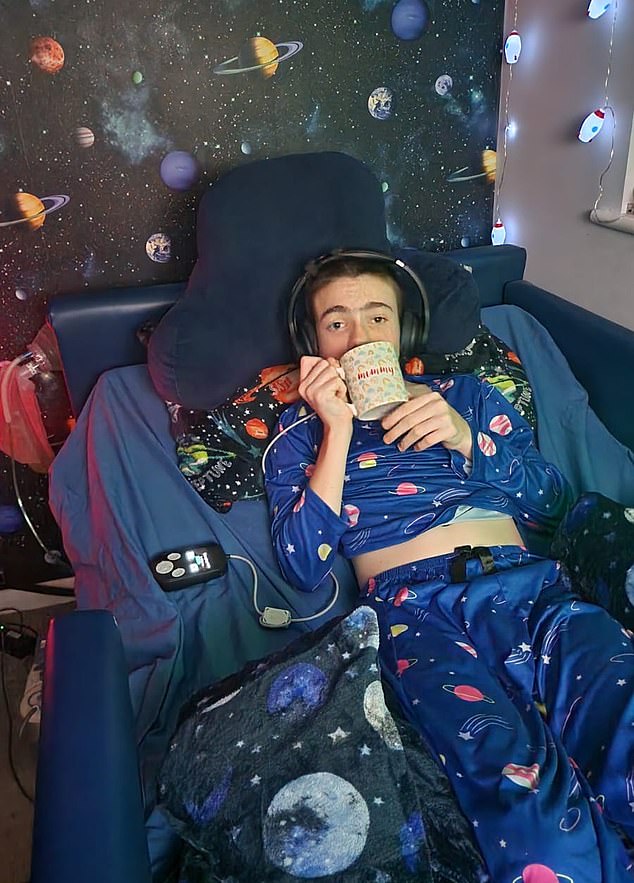An adolescent affected by extreme epilepsy has turn out to be the primary affected person on this planet whose seizures have been managed by an implant positioned on the cranium.
Oran Knowlson seen an 80 % discount in daytime seizures resulting from a neurotransmitter that sends electrical indicators deep in his mind.
The 13-year-old from Somerset has suffered from a treatment-resistant type of epilepsy referred to as Lennox-Gastaut syndrome for the reason that age of three.
He suffered day by day seizures, which typically triggered him to fall to the bottom, shake violently, and go out.
However now, eight months after his life-changing operation as a part of a trial at Nice Ormond Road Hospital london, The teenager's future appears 'promising' and she or he is extra 'talkative' and 'engaged'.

Oran Knowlson, 13, noticed his daytime seizures lower by 80 per cent due to a neurotransmitter that sends electrical indicators deep in his mind.
Oran's seizures started two weeks after his third birthday and had not had a single seizure till the trial.
After some seizures he would want emergency medicine to revive him as a result of he had stopped respiratory.
As a result of severity of his epilepsy he required 24-hour care for many of his life, as seizures may happen at any time of the day, and he had a considerably elevated threat of sudden surprising loss of life in epilepsy (SUDEP).
'Oran was hitting all of his milestones earlier than the seizures began, however because the seizures grew to become extra extreme, we misplaced increasingly of Oran. From a contented, energetic three-year-old, he struggled to have interaction with the world resulting from his medicine and seizures – however he nonetheless has a humorousness,' mentioned Justine Knowlson, Oran's mother.
He added: 'We've tried all the pieces however that is the primary time in a few years we've been given an actual shot, there's been no “what subsequent” up to now. Till somebody takes step one in a trial like this, it's not going to get any higher and it has to get higher for our household.'
Lennox-Gastau syndrome impacts about one or two out of each 100 youngsters with epilepsy, normally starting when the kid is between three months and 5 years outdated.
The uncommon epilepsy syndrome causes common seizures and studying difficulties.
Oran is a part of the CADET (Youngsters's Adaptive Deep Mind Stimulation Trial for Epilepsy) mission, a sequence of trials assessing the protection and effectiveness of deep mind stimulation for extreme epilepsy.
The partnership contains Nice Ormond Road Hospital, College Faculty London, King's Faculty Hospital and the College of Oxford.
Epileptic seizures are attributable to irregular bursts {of electrical} exercise within the mind.
However the Picostim neurotransmitter, a chargeable gadget made by UK firm Ember Therapeutics, works by emitting a steady pulse {of electrical} present to dam these irregular indicators.
It’s worn on the scalp and related to electrodes deep within the mind to scale back seizure exercise.
Oran underwent surgical procedure in October 2023, after which the gadget was inserted and as soon as he recovered from the process, it was turned 'on', delivering fixed electrical stimulation to Oran's mind. Since then, Oran and his household's lives have fully modified.
Ms Knowlson mentioned: 'We've been engaged on this since December and we've seen a variety of enchancment, the seizures have decreased and turn out to be much less extreme. It's nice however the improved high quality of life has been invaluable for Oran.
'He's turn out to be much more talkative, he's much more engaged. He's 13 and I’ve a youngster now – he's completely happy to inform me 'no'. However when he can categorical himself higher, it provides to his high quality of life.
'The crew is actually with you. Now we have by no means felt lonely since final August [when we joined the trial]We had been made to really feel a part of the crew, and so was Oran.
'The longer term appears hopeful, which I couldn't have even dreamed of six months in the past. For Oran, having hope brings pleasure. It makes the longer term look brighter and extra achievable. I'm actually glad Oran has had the prospect to expertise this.'
Sometimes, deep mind stimulation (DBS), a remedy that includes surgically inserting a small gadget that stimulates particular elements of the mind, is finished by inserting the gadget on the chest and working wires by means of the neck to the mind.
However this gadget is utilized to the scalp, which suggests it's much less prone to break or put on out as a toddler grows.

The gadget could be recharged through wearable headphones (pictured), which work by emitting a relentless pulse {of electrical} present to dam out these irregular indicators

Since having the implant, Oran's high quality of life has improved and he has turn out to be extra 'talkative and engaged'
It may also be recharged by means of wearable headphones, which can be utilized whereas watching movies or interacting with the pill.
This additionally signifies that sufferers is not going to must bear surgical procedure each three to 5 years to switch it.
This implant targets the thalamus, which is the middle {of electrical} indicators within the mind.
It’s hoped that this gadget will block {the electrical} pathways and consequently forestall the seizure from spreading.
It additionally has settings for optimizing seizure patterns, which, though not used on this trial, may very well be used sooner or later for sufferers with Lennox-Gastaut syndrome.
'Day-after-day we see the life-threatening and life-limiting results of uncontrolled epilepsy. It could make faculty, hobbies and even watching favorite TV exhibits inconceivable,' mentioned Martin Tisdall, Marketing consultant Paediatric Neurosurgeon at GOSH and Honorary Affiliate Professor at UCL.
'For Oran and his household, epilepsy fully modified their lives and so it’s completely superb to see him using a horse and regaining his independence. We’re so happy to be a part of his journey.
'Deep mind stimulation brings us nearer than ever to stopping epileptic seizures for sufferers who’ve very restricted efficient remedy choices.
'We’re excited to be constructing the proof base to reveal the potential of deep mind stimulation to deal with childhood epilepsy and hope that within the coming years this can be an ordinary remedy that we can present.'
The CADET trial is now involving three extra sufferers with Lennox-Gastaut syndrome as a part of a pilot, funded by the Royal Academy of Engineering. An extra 22 sufferers will participate within the full trial, funded by the GOSH charity and LifeArc and sponsored by College Faculty London.


